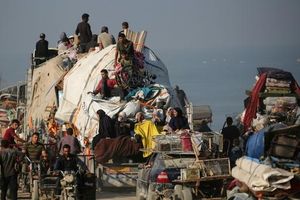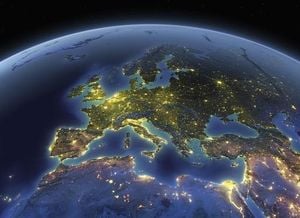The Maya Train project, often seen as Mexico's ambitious leap toward modernizing its transportation infrastructure, has recently faced scrutiny and challenges, but it's not diminishing the excitement surrounding its future prospects. Launched as part of President Andrés Manuel López Obrador's broader vision to boost tourism and create jobs, the train, officially termed Tren Maya, aims to connect various destinations throughout the Yucatán Peninsula.
This considerable railway project stretches approximately 1,500 kilometers across five states: Chiapas, Tabasco, Campeche, Yucatán, and Quintana Roo. Its goal is to not only ease travel within the region but to promote economic growth by linking popular tourist spots like Tulum, Playa del Carmen, and Merida. While the promise of quicker travel for both residents and tourists remains high, the route has been marred by controversies related to environmental impact and indigenous rights.
Critics of the Maya Train have been vocal about the potential damage to local ecosystems and the cultural disruptions it could cause to indigenous communities living along the route. Environmentalists have raised alarming concerns over deforestation, habitat fragmentation, and threats to biodiversity, pointing to the fact extensive land clearance is required for construction. Proponents counter these claims by emphasizing the project's contribution to the economy, as it is projected to create thousands of jobs and attract millions of tourists.
Despite the hurdles, Mexico's government remains optimistic. The project is expected to boost the economy significantly. According to officials, the Maya Train is anticipated to generate around $3 billion annually, primarily from tourism. President López Obrador has described the project as part of his commitment to ensuring development reaches the southern states, which have historically lagged behind wealthier regions. "The trains will provide connectivity and equal opportunities for regions where they never had them before," he argued during one of the project's many promotional events.
Yet, skeptics urge caution, noting the complications faced by similar projects, such as the high-speed rail project between Mexico City and Querétaro, which was initially promised to revolutionize travel between the two destinations. Construction of the latter project has seen delays and economic strains, raising eyebrows about the execution of the Maya Train.
For now, trains are running but still not achieving full operational capacity. Recent reports indicate the train has been met with limited tourist uptake since launching its passenger service, which has led to questions surrounding the long-term viability of the project if ridership does not increase significantly.
There's also growing anticipation surrounding new inter-city railway projects, particularly the Mexico City to Querétaro line, which is proposed to be operational by early 2025. This $7.8 billion investment indicates Mexico's commitment to enhancing its rail infrastructure. The government plans to lay over 1,864 miles of tracks, with the Querétaro line viewed as one of the new administration's key priorities. The train will significantly reduce travel time and provide passengers with new travel alternatives.
On the subject of the Maya Train, General Gustavo Ricardo Vallejo announced, "The project exists, and there is political will for its completion and growth." This quote embodies the sentiment shared among many politicians who see this railway as beneficial not just for local economies but for the national image.
Meanwhile, travelers and locals are hopeful. The Maya Train promises to offer not just a shortcut but also scenic views showcasing the beauty of Mexico's diverse landscapes, historic sites, and archaeological treasures. Train stations along the route are being developed to mirror the cultural heritage of their locations, with architecture reflecting traditional styles.
Yet, locals also express frustration as issues continue to plague the service. Reports of delays and technical difficulties have sparked worries about the train’s efficiency. Some describe the experience aboard as still raw, with amenities still being optimized. Nevertheless, some passengers have shared positive experiences, marketing it as “a unique opportunity to experience Mexico differently.”
The entrepreneurial spirit has also been awakened along the route, as many locals are positioning themselves to reap the benefits of this new era of travel. Businesses are springing up, providing everything from guided tours around archaeological sites to souvenirs celebrating the rich cultural past of the Yucatán.
Despite the criticisms and logistical hiccups, one thing remains clear: the Maya Train, like any large-scale infrastructure project, is not just about trains and tracks. It’s about people, their history, their culture, and their hopes for the future. For many, this train symbolizes progress – the potential for greater connectivity and economic stability.
While it's uncertain whether the Maya Train will achieve its lofty expectations amid continuing challenges, many along its route remain committed to its potential for transforming travel across the region. The train may be just the beginning of what promises to be Mexico's grand transportation revolution.
For those considering travel plans, exploring cities preserved by centuries of history and blending the old with the new is enticing. Queretaro, for example, is gaining attention alongside the new rail links, with its UNESCO World Heritage site status promising travelers rich historical experiences. The beauty of Queretaro is just one stop along the budding network, juxtaposing modernity with the remnants of colonial grandeur, represented through its vibrant local culture and culinary delights.
With construction ramping up and projects like the Mexico City-Queretaro line on the horizon, travelers can look forward to expanded rail routes and smoother connections. The expanded rail system aims to change how locals and tourists experience the culture, as well as streamline commutes through some of Mexico’s most scenic routes.
Whether the results will mirror the excitement and potential set out by the government, only time will tell, but the dedication to moving forward—even through the uncertainty—illustrates the drive to revolutionize train travel and tourism across Mexico once and for all.



